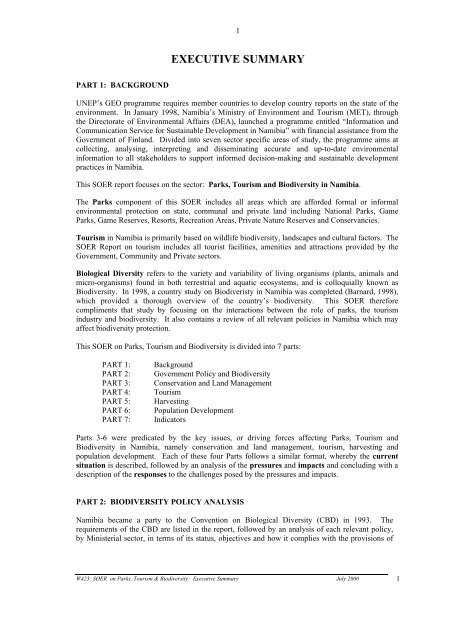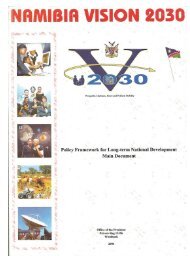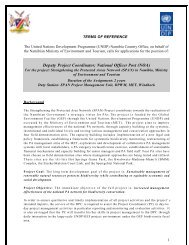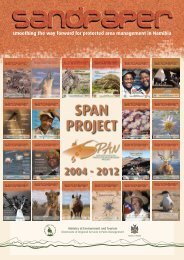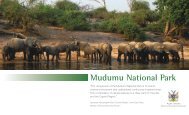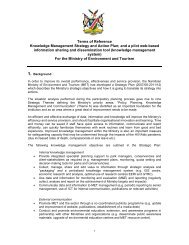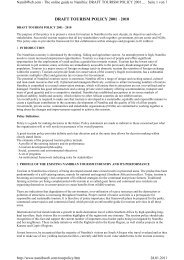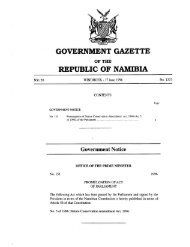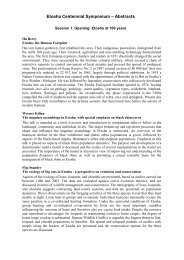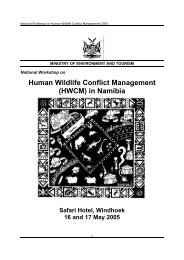EXECUTIVE SUMMARY - Ministry of Environment and Tourism
EXECUTIVE SUMMARY - Ministry of Environment and Tourism
EXECUTIVE SUMMARY - Ministry of Environment and Tourism
Create successful ePaper yourself
Turn your PDF publications into a flip-book with our unique Google optimized e-Paper software.
1<br />
<strong>EXECUTIVE</strong> <strong>SUMMARY</strong><br />
PART 1: BACKGROUND<br />
UNEP’s GEO programme requires member countries to develop country reports on the state <strong>of</strong> the<br />
environment. In January 1998, Namibia’s <strong>Ministry</strong> <strong>of</strong> <strong>Environment</strong> <strong>and</strong> <strong>Tourism</strong> (MET), through<br />
the Directorate <strong>of</strong> <strong>Environment</strong>al Affairs (DEA), launched a programme entitled “Information <strong>and</strong><br />
Communication Service for Sustainable Development in Namibia” with financial assistance from the<br />
Government <strong>of</strong> Finl<strong>and</strong>. Divided into seven sector specific areas <strong>of</strong> study, the programme aims at<br />
collecting, analysing, interpreting <strong>and</strong> disseminating accurate <strong>and</strong> up-to-date environmental<br />
information to all stakeholders to support informed decision-making <strong>and</strong> sustainable development<br />
practices in Namibia.<br />
This SOER report focuses on the sector: Parks, <strong>Tourism</strong> <strong>and</strong> Biodiversity in Namibia.<br />
The Parks component <strong>of</strong> this SOER includes all areas which are afforded formal or informal<br />
environmental protection on state, communal <strong>and</strong> private l<strong>and</strong> including National Parks, Game<br />
Parks, Game Reserves, Resorts, Recreation Areas, Private Nature Reserves <strong>and</strong> Conservancies.<br />
<strong>Tourism</strong> in Namibia is primarily based on wildlife biodiversity, l<strong>and</strong>scapes <strong>and</strong> cultural factors. The<br />
SOER Report on tourism includes all tourist facilities, amenities <strong>and</strong> attractions provided by the<br />
Government, Community <strong>and</strong> Private sectors.<br />
Biological Diversity refers to the variety <strong>and</strong> variability <strong>of</strong> living organisms (plants, animals <strong>and</strong><br />
micro-organisms) found in both terrestrial <strong>and</strong> aquatic ecosystems, <strong>and</strong> is colloquially known as<br />
Biodiversity. In 1998, a country study on Biodiveristy in Namibia was completed (Barnard, 1998),<br />
which provided a thorough overview <strong>of</strong> the country’s biodiversity. This SOER therefore<br />
compliments that study by focusing on the interactions between the role <strong>of</strong> parks, the tourism<br />
industry <strong>and</strong> biodiversity. It also contains a review <strong>of</strong> all relevant policies in Namibia which may<br />
affect biodiversity protection.<br />
This SOER on Parks, <strong>Tourism</strong> <strong>and</strong> Biodiversity is divided into 7 parts:<br />
PART 1:<br />
PART 2:<br />
PART 3:<br />
PART 4:<br />
PART 5:<br />
PART 6:<br />
PART 7:<br />
Background<br />
Government Policy <strong>and</strong> Biodiversity<br />
Conservation <strong>and</strong> L<strong>and</strong> Management<br />
<strong>Tourism</strong><br />
Harvesting<br />
Population Development<br />
Indicators<br />
Parts 3-6 were predicated by the key issues, or driving forces affecting Parks, <strong>Tourism</strong> <strong>and</strong><br />
Biodiversity in Namibia, namely conservation <strong>and</strong> l<strong>and</strong> management, tourism, harvesting <strong>and</strong><br />
population development. Each <strong>of</strong> these four Parts follows a similar format, whereby the current<br />
situation is described, followed by an analysis <strong>of</strong> the pressures <strong>and</strong> impacts <strong>and</strong> concluding with a<br />
description <strong>of</strong> the responses to the challenges posed by the pressures <strong>and</strong> impacts.<br />
PART 2: BIODIVERSITY POLICY ANALYSIS<br />
Namibia became a party to the Convention on Biological Diversity (CBD) in 1993. The<br />
requirements <strong>of</strong> the CBD are listed in the report, followed by an analysis <strong>of</strong> each relevant policy,<br />
by Ministerial sector, in terms <strong>of</strong> its status, objectives <strong>and</strong> how it complies with the provisions <strong>of</strong><br />
W423: SOER on Parks, <strong>Tourism</strong> & Biodiversity: Executive Summary July 2000 1
2<br />
the CBD. Recommendations to remedy any deficiencies are made. The policies covered are listed<br />
in Table A below.<br />
TABLE A: LIST OF POLICIES ANALYSED IN TERMS OF THE CONVENTION FOR<br />
BIOLOGICAL DIVERSITY<br />
Institution<br />
<strong>Ministry</strong> Of Agriculture, Water And<br />
Rural Development<br />
National Planning Commission<br />
<strong>Ministry</strong> Of Fisheries And Marine<br />
Resources<br />
<strong>Ministry</strong> Of <strong>Environment</strong> And<br />
<strong>Tourism</strong><br />
<strong>Ministry</strong> Of L<strong>and</strong>s, Resettlement<br />
And Rehabilitation<br />
<strong>Ministry</strong> Of Higher Education,<br />
Science And Technology<br />
Other<br />
Policies/White Papers/Legislation<br />
National Agricultural Policy<br />
1. National Population Policy For Sustainable Human<br />
Development<br />
2. Regional Planning And Development Policy<br />
1. The Sea Fisheries Act<br />
2. Draft Inl<strong>and</strong> Fisheries Bill (1999)<br />
1. Namibia’s 12 Point Plan For Integrated And<br />
Sustainable <strong>Environment</strong>al Management<br />
2. The <strong>Tourism</strong> White Paper And <strong>Tourism</strong> Policy<br />
3. L<strong>and</strong> Use Planning<br />
4. <strong>Environment</strong>al Assessment And The Draft<br />
<strong>Environment</strong>al Management Act<br />
5. The Forest Act<br />
6. Conservation Of Biotic Diversity And Habitat<br />
Protection<br />
7. Wildlife Management, Utilisation And <strong>Tourism</strong> In<br />
Communal Area<br />
8. Research<br />
9. Climate Change<br />
1. National L<strong>and</strong> Policy<br />
2. Communal L<strong>and</strong> Reform Bill<br />
White Paper On Science And Technology Policy<br />
1. Biotechnology<br />
2. Prospecting And Mining In Protected Areas And<br />
National Monuments<br />
PART 3: CONSERVATION AND LAND MANAGEMENT<br />
Current Status <strong>of</strong> L<strong>and</strong> Ownership <strong>and</strong> L<strong>and</strong> Management in Namibia<br />
This section examines the current status <strong>of</strong> the l<strong>and</strong> tenure system, parks <strong>and</strong> protected areas,<br />
biodiversity <strong>and</strong> the administrative structure relating to l<strong>and</strong> ownership <strong>and</strong> conservation in<br />
Namibia.<br />
L<strong>and</strong> Tenure System<br />
Namibia is divided into commercial farml<strong>and</strong> (mainly in the savanna <strong>and</strong> semi-desert areas <strong>of</strong> the<br />
south <strong>and</strong> centre), communal l<strong>and</strong> (former “homel<strong>and</strong>s”, largely in the north), state protected nature<br />
areas, tourist recreational areas, <strong>and</strong> mining areas as shown in Figure 1<br />
W423: SOER on Parks, <strong>Tourism</strong> & Biodiversity: Executive Summary July 2000 2
3<br />
Fig. 1<br />
W423: SOER on Parks, <strong>Tourism</strong> & Biodiversity: Executive Summary July 2000 3
4<br />
Colonial intervention in the social <strong>and</strong> economic development <strong>of</strong> Namibia has produced a stark<br />
tenurial dualism in Namibia. Roughly half the non-state l<strong>and</strong> continues to be held under freehold<br />
title while no freehold titles can be obtained in the other half. Prior to independence, l<strong>and</strong> in the<br />
communal farming areas was held in communal ownership. L<strong>and</strong> rights were allocated by<br />
traditional leaders <strong>and</strong> not registered in a formal registry <strong>and</strong> therefore, there was no security <strong>of</strong><br />
tenure. Communal l<strong>and</strong>, where the majority <strong>of</strong> Namibians live, now belongs to the State according<br />
to the Namibian Constitution, <strong>and</strong> farmers have only usufruct rights.<br />
Commercial farming areas operate under a freehold title system whereby each farmer owns his l<strong>and</strong><br />
<strong>and</strong> such ownership is registered.<br />
The principle that sustainable resources <strong>and</strong> l<strong>and</strong> management depend to a large extent on the l<strong>and</strong><br />
tenure regime prevailing in a particular area is now accepted. It has been argued that communities<br />
will not be able to manage natural resources responsibly on a collective basis without clear rights to<br />
these resources.<br />
While the State has transferred limited use rights <strong>of</strong> some natural resources to rural communities in<br />
the form <strong>of</strong> conservancies, for example, such communities still do not have any property rights<br />
over l<strong>and</strong> as such. While the National L<strong>and</strong> Policy White Paper alludes to community ownership<br />
<strong>of</strong> l<strong>and</strong> <strong>and</strong> natural resources, the Communal L<strong>and</strong> Reform Bill does not address this issue at all. It<br />
is very clear that there is lack <strong>of</strong> secure <strong>and</strong> exclusive rights to l<strong>and</strong> <strong>and</strong> resources on the communal<br />
l<strong>and</strong>s, <strong>and</strong> this needs to be addressed because it seems to be the ultimate root cause <strong>of</strong> unsustainable<br />
resource exploitation.<br />
Current Status <strong>of</strong> Parks <strong>and</strong> Protected Areas<br />
Namibia has 21 proclaimed parks <strong>and</strong> nature reserves which make up about 14% <strong>of</strong> Namibia’s l<strong>and</strong><br />
area. The parks, conservation areas <strong>and</strong> recreational resorts represent all the main biomes in<br />
Namibia – ranging from the dune seas <strong>of</strong> the Namib <strong>and</strong> the dwarf scrub savanna <strong>of</strong> Etosha to the<br />
species-rich flood plains <strong>of</strong> Kavango <strong>and</strong> the Eastern Caprivi. These state-controlled conservation<br />
areas form the protected area network. This percentage (14%) exceeds the 10% recommended by<br />
IUCN to be set aside for conservation. However, the distribution <strong>of</strong> these conservation areas is<br />
highly skewed towards desert <strong>and</strong> saline desert habitats, thus Namibia’s ecological diversity is not<br />
evenly represented in this network - only 4 <strong>of</strong> the 13 vegetation types are comprehensively<br />
protected.<br />
Since the beginning <strong>of</strong> 1999, 20 <strong>of</strong> the state owned resorts <strong>and</strong> campsites have been under the<br />
management <strong>of</strong> Namibia Wildlife Resorts Limited (NWR). Namibia’s parks <strong>and</strong> nature reserves<br />
constitute the backbone <strong>of</strong> the country’s tourist industry. Their contribution to the Gross Domestic<br />
Product was N$ 1 300 million in 1998 <strong>and</strong> it is estimated that by the year 2002 the sector will<br />
contribute N$ 2 billion to Namibia’s GDP.<br />
The value <strong>of</strong> wildlife in National Parks <strong>and</strong> Game Reserves is not easy to assess. Some <strong>of</strong> the<br />
direct uses occur in the market economy, particularly tourism <strong>and</strong> the limited capture for live sale,<br />
but <strong>of</strong>ten not at market prices. Other direct uses, such as research, education, <strong>and</strong> aesthetic pleasure<br />
cannot be easily valued, while some <strong>of</strong> the most important values <strong>of</strong> national parks lie in their<br />
indirect benefits <strong>and</strong> non-use values: maintenance <strong>of</strong> essential ecological functions, <strong>and</strong> the<br />
existence <strong>and</strong> option value <strong>of</strong> bio-diversity they preserve. Without the protected areas, economic<br />
benefits generated from wildlife on communal <strong>and</strong> commercial l<strong>and</strong>, <strong>and</strong> in the tourism industry<br />
more broadly, would be severely diminished.<br />
W423: SOER on Parks, <strong>Tourism</strong> & Biodiversity: Executive Summary July 2000 4
5<br />
Privately owned nature reserves can play a significant role in biodiversity protection in Namibia.<br />
Some are extremely rich in endemic species, unique l<strong>and</strong>scape features or both. Both categories<br />
are fairly abundant on commercial farml<strong>and</strong>. There were 148 private nature reserves totalling 7<br />
642 km 2 or 0.9% <strong>of</strong> Namibia’s l<strong>and</strong> area as <strong>of</strong> 1995. All <strong>of</strong> these are registered with the <strong>Ministry</strong> <strong>of</strong><br />
<strong>Environment</strong> <strong>and</strong> <strong>Tourism</strong>.<br />
In additional to the private nature reserves many farmers have pooled (natural <strong>and</strong> financial)<br />
resources for the purpose <strong>of</strong> conserving <strong>and</strong> using wildlife sustainably. These areas are known as<br />
private conservancies <strong>and</strong> have to be registered with the MET. Members practise normal farming<br />
activities <strong>and</strong> operations in combination with wildlife conservation. Conservancies are managed<br />
<strong>and</strong> operated by members through a committee. A total <strong>of</strong> 22 private conservancies have been<br />
formed to date.<br />
Communal l<strong>and</strong> conservancies operate on the same principles as commercial l<strong>and</strong> conservancies,<br />
differing only in management structures. A community or a group <strong>of</strong> communities within a defined<br />
locality constitutes the management structure <strong>of</strong> communal l<strong>and</strong> conservancies. At present<br />
Namibia has nine proclaimed communal area conservancies, <strong>and</strong> approximately 20 are in the<br />
proposal stage.<br />
The absence <strong>of</strong> conservancies from large parts <strong>of</strong> the country, especially the southern regions, is<br />
due to the fact that the first conservancies started where wildlife was still relatively abundant.<br />
However, attention is being given to the establishment <strong>of</strong> conservancies in the north-central <strong>and</strong><br />
other regions to redress this situation, starting with the re-introduction <strong>of</strong> wildlife.<br />
Whereas in the past, rural communities suffered from crop <strong>and</strong> livestock loss as a result <strong>of</strong> wild<br />
animals, while receiving limited benefits from public <strong>and</strong> private sector wildlife conservation,<br />
conservancies allow rural communities to enjoy the commercial benefits <strong>of</strong> wildlife conservation.<br />
In sum, conservancies promote sustainable environmental management <strong>and</strong> rural development. For<br />
example, the following facts pertain:<br />
• to date approximately 9 500 adults have registered in established conservancies <strong>and</strong> at<br />
least a further 4 300 adults have been registered in emerging conservancies;<br />
• approximately 22 000 km² have been registered as conservancies on the communal<br />
l<strong>and</strong>s in Namibia.;<br />
• a further 38 000 km² are being formed into conservancies by meeting the requirements<br />
as laid out by the MET;<br />
• approximately 7% <strong>of</strong> all communal l<strong>and</strong> in Namibia has been registered as<br />
conservancies <strong>and</strong> a further 12% is in the process <strong>of</strong> being included in conservancies;<br />
• two conservancies have completed detailed tourism plans;<br />
• at least 5 conservancies plan to develop detailed tourism plans during 2000;<br />
• the combined financial income <strong>of</strong> conservancies to date is just below N$2 million;<br />
• the annual operating costs <strong>of</strong> the conservancies, where data are available, are more than<br />
N$1.3 million;<br />
• three conservancies have started taking over their conservancy running costs.<br />
Since it is estimated that more than 75% <strong>of</strong> Namibia’s large mammals are found outside formally<br />
protected areas, key species such as elephants, leopards, cheetahs <strong>and</strong> antelope move freely<br />
between parks <strong>and</strong> neighbouring l<strong>and</strong>. Thus, privately owned farms, private nature reserves <strong>and</strong><br />
conservancies can compliment the national Government’s wildlife conservation initiatives.<br />
W423: SOER on Parks, <strong>Tourism</strong> & Biodiversity: Executive Summary July 2000 5
6<br />
Status <strong>of</strong> Biodiversity in Namibia<br />
It is clear that there is a general lack <strong>of</strong> baseline data on the diversity <strong>and</strong> ecology <strong>of</strong> most<br />
Namibian flora <strong>and</strong> fauna in spite <strong>of</strong> the fact that a relatively high proportion <strong>of</strong> Namibia is under<br />
some form <strong>of</strong> state, communal <strong>and</strong> private conservation (15%). This paucity <strong>of</strong> information on the<br />
biogeography <strong>and</strong> ecological requirements <strong>of</strong> species means that the conservation status <strong>of</strong> most<br />
groups remains ill defined (see Table B). Birds are probably the best known group but even here<br />
there are inevitable gaps in the knowledge base, especially with regard to ecological <strong>and</strong> habitat<br />
requirements.<br />
TABLE B: <strong>SUMMARY</strong> OF BIODIVERSITY OF HIGHER ORDER PLANTS AND ANIMALS<br />
No <strong>of</strong><br />
species<br />
known in<br />
Namibia<br />
No <strong>of</strong><br />
endemics<br />
known in<br />
Namibia<br />
Knowledge base<br />
in Namibia<br />
Main known threats in Namibia<br />
Fungi 190 None Poor<br />
Insufficient information<br />
known<br />
Lichens 330 Several Poor Off road driving in the desert<br />
Plants 4344 687 266 sp have RDB<br />
status<br />
Population increase, dem<strong>and</strong> for<br />
plant resources, deforestation,<br />
overgrazing, fire, over-harvesting,<br />
illegal trade, inadequate protection in<br />
PAN<br />
Arachnids 1357 Several Only 20% <strong>of</strong> total<br />
sp known<br />
Insufficient information. Lack formal<br />
protection in PAN<br />
Myriapods 45 14 Poor Habitat degradation<br />
Insects 6400 1540 Reasonable Habitat degradation. Lack <strong>of</strong><br />
sufficient knowledge <strong>of</strong> impacts<br />
Fish<br />
(freshwater)<br />
115 5 Reasonable Overfishing, habitat destruction,<br />
water abstraction, aliens, poor<br />
catchment management<br />
Amphibians 50 6 Reasonable Habitat loss along perennial rivers<br />
Reptiles 260 55 Mostly poorly<br />
known; 34 sp in<br />
possible threat<br />
categories<br />
Birds 658 14 Well known; 86 sp<br />
in possible threat<br />
categories<br />
Mammals<br />
250 (incl<br />
marine)<br />
14 Well known,<br />
except in small<br />
mammal groups;<br />
40 in possible<br />
threat categories<br />
Habitat alteration, illegal trade<br />
Habitat degradation, hunting,<br />
poisoning<br />
Habitat degradation <strong>and</strong> loss,<br />
overgrazing by domestic stock,<br />
deforestation, fire, hunting <strong>and</strong> illegal<br />
trade<br />
There are several areas <strong>of</strong> special ecological importance in Namibia which require urgent<br />
conservation protection:<br />
• the Kaoko escarpment including the Br<strong>and</strong>berg <strong>and</strong> nearby inselbergs <strong>and</strong> granite domes;<br />
• the southern Namib centre <strong>of</strong> endemism in the Sperrgebiet;<br />
• the woodl<strong>and</strong>s, floodplains <strong>and</strong> riparian vegetation <strong>of</strong> the perennial rivers <strong>and</strong> surrounding areas<br />
in the Caprivi;<br />
W423: SOER on Parks, <strong>Tourism</strong> & Biodiversity: Executive Summary July 2000 6
7<br />
• the mountain savanna <strong>and</strong> karstveld <strong>of</strong> the Otavi mountainl<strong>and</strong>s;<br />
• the dwarf shrub savanna <strong>of</strong> the Brukkaros crater.<br />
In addition to these 5 areas <strong>of</strong> concern there are numerous more localised sites which need some<br />
sort <strong>of</strong> protection. These fall into several general categories, including: caves <strong>and</strong> sinkholes; inl<strong>and</strong><br />
wetl<strong>and</strong>s; the coastal zone; mountains <strong>and</strong> inselbergs; the Namib s<strong>and</strong> sea; <strong>and</strong> the winter rainfall<br />
area <strong>of</strong> south-western Namibia. Most <strong>of</strong> these areas are poorly known as far as resident biota <strong>and</strong><br />
ecological functioning is concerned <strong>and</strong> warrant considerable further research.<br />
Namibia is fortunate in not having large numbers <strong>of</strong> problematic invasive species introduced from<br />
elsewhere in the world in spite <strong>of</strong> the fact that control programmes are relatively limited <strong>and</strong> the<br />
legislative framework is outdated <strong>and</strong> inadequate.<br />
Pressures on Conservation <strong>and</strong> L<strong>and</strong> Management<br />
Thirteen pressures on conservation <strong>and</strong> l<strong>and</strong> management were identified:<br />
• lack <strong>of</strong> secure <strong>and</strong> exclusive tenure;<br />
• lack <strong>of</strong> legal protection from development in parks <strong>and</strong> protected areas;<br />
• lack <strong>of</strong> government commitment in terms <strong>of</strong> resources, financial support, training <strong>and</strong><br />
research;<br />
• lack <strong>of</strong> inter-sectoral co-ordination;<br />
• inappropriate range management systems;<br />
• lack <strong>of</strong> research into wildlife management <strong>and</strong> production;<br />
• fencing;<br />
• frequent fires;<br />
• climatic change;<br />
• social development <strong>and</strong> poverty;<br />
• harvesting <strong>and</strong> trade in species;<br />
• economic development;<br />
• unsustainable government subsidies <strong>and</strong> incentives.<br />
These are discussed more fully in the report.<br />
Impacts on Conservation <strong>and</strong> L<strong>and</strong> Management<br />
The pressures on conservation <strong>and</strong> l<strong>and</strong> management listed above can result in a number <strong>of</strong> impacts<br />
on the environment, such as:<br />
Desertification. The indications <strong>of</strong> desertification in Namibia include declining ground water<br />
levels, soil erosion, loss <strong>of</strong> woody vegetation, loss <strong>of</strong> grasses <strong>and</strong> shrubs, bush encroachment,<br />
increased soil-salt content <strong>and</strong> decreased soil fertility. The direct causes <strong>of</strong> desertification in<br />
Namibia are too many people <strong>and</strong> livestock occupying one place for too long (contributing to<br />
overgrazing <strong>and</strong> deforestation), inappropriate provision <strong>of</strong> artificial water points, inappropriate<br />
irrigation <strong>and</strong> other crop cultivation practices, absentee farm management, <strong>and</strong> inappropriate<br />
fencing in dry areas. The background causes <strong>of</strong> desertification in Namibia are the rapidly<br />
increasing population, lack <strong>of</strong> consideration for low <strong>and</strong> variable rainfall, national <strong>and</strong> international<br />
policies <strong>and</strong> economics, <strong>and</strong> socio-economic factors, especially poverty.<br />
Loss in Biodiversity through over-exploitation <strong>of</strong> resources, open access <strong>and</strong> habitat conversion.<br />
Economic Impacts. <strong>Tourism</strong> contributes about 4% to the Gross Domestic Product (GDP) <strong>of</strong><br />
Namibia <strong>and</strong> is the third largest earner <strong>of</strong> foreign exchange. However, tourism is highly dependent<br />
W423: SOER on Parks, <strong>Tourism</strong> & Biodiversity: Executive Summary July 2000 7
8<br />
on the quality <strong>of</strong> the environment; problems such as overcrowding, erosion, litter, bush<br />
encroachment, loss <strong>of</strong> biodiversity, fire damage <strong>and</strong> veld degradation could seriously undermine<br />
the quality <strong>of</strong> the tourist experience, with a consequential decline in the number <strong>of</strong> visitors. A drop<br />
in tourist income will affect the economic viability <strong>of</strong> the parks <strong>and</strong> conservancies, which will<br />
struggle to pay their way.<br />
This would result in cuts in personnel, resources <strong>and</strong> maintenance activities. This spiralling decline<br />
will have significant consequences for the rural population, as well as affecting the Government’s<br />
bottom line. The impacts will reverberate through both forward <strong>and</strong> backward economic linkages.<br />
Responses to Conservation <strong>and</strong> L<strong>and</strong> Management Pressures<br />
Financial Response<br />
A number <strong>of</strong> NGO’s support the communal conservancies, particularly LIFE, Rössing Foundation,<br />
IRDNC, NACOBTA <strong>and</strong> NNF. These <strong>and</strong> other government environmental projects are funded by<br />
overseas donors (see Table 3.11 in the main report).<br />
Institutional Response<br />
The commercialisation <strong>of</strong> many <strong>of</strong> the country’s parks <strong>and</strong> resorts through the creation <strong>of</strong> Namibia<br />
Wildlife Resorts is hoped to address many <strong>of</strong> the current problems <strong>and</strong> pressures on parks.<br />
The forthcoming <strong>Environment</strong>al Management Act will formalise the need for most future<br />
developments to carry out an environmental impact assessment at some level. This should reduce the<br />
negative impact <strong>of</strong> development on the environment, while allowing income-generating<br />
developments to take place in a sustainable manner.<br />
Administrative Response<br />
Namibia has a current National Development Plan which is being updated for the period 2000/1 –<br />
2005/6,, <strong>and</strong> integrated Regional Development Plans are also being developed. The latter include<br />
environmental factors in the consideration <strong>of</strong> development options.<br />
Furthermore, l<strong>and</strong> use plans have been, <strong>and</strong> are being developed for certain areas such as: Kunene<br />
Region, Caprivi, Bushmanl<strong>and</strong> <strong>and</strong> The Sperrgebiet. The Coastal Zone Management Plans <strong>of</strong> the<br />
Kunene <strong>and</strong> Erongo Regions aim to establish a system for sustainable development by maintaining<br />
the long term economic <strong>and</strong> ecological potential <strong>of</strong> the zone.<br />
At a smaller scale, one <strong>of</strong> the Government’s requirements for communal conservancies is to develop<br />
a comprehensive management plan. Four conservancies have achieved this goal. MET is also in the<br />
process <strong>of</strong> drawing up management plans for a number <strong>of</strong> protected areas such as: The Orange River<br />
mouth, Ai-Ais/Huns <strong>and</strong> the Namib Naukluft Park.<br />
A key initiative by the Government is the Parks <strong>and</strong> Neighbours Relations Policy which seeks to<br />
provide incentives for the people living next to a Park to benefit from the presence <strong>of</strong> the park.<br />
Several negotiations are underway.<br />
W423: SOER on Parks, <strong>Tourism</strong> & Biodiversity: Executive Summary July 2000 8
9<br />
PART 4: TOURISM<br />
Current Situation Regarding <strong>Tourism</strong><br />
<strong>Tourism</strong> is the world’s fastest growing industry. According to the WTO, receipts from international<br />
tourism have increased by an average 9% annually for the past 16 years to reach US$423 billion in<br />
1996; this is predicted to grow to US$621 billion by the year 2000. But, only 27 million or 4.1% <strong>of</strong><br />
these tourists will visit Africa in 2000.<br />
In the case <strong>of</strong> southern Africa, the growth rate estimated by the WTO for the next 20 years is slightly<br />
better than that for the continent: a 7.5% growth per annum compared to a 5.5% annual growth for<br />
the continent. With a 2% share in world tourism arrivals at present for the SADC countries, there is<br />
plenty <strong>of</strong> scope for an improvement in the tourism performance <strong>of</strong> this region.<br />
<strong>Tourism</strong> in Namibia is a very important contributor to the national economy <strong>and</strong> also an increasingly<br />
important job creator. It is estimated that during 1998 this sector made a contribution <strong>of</strong> N$1 300<br />
million (4%) to the Gross Domestic Product (GDP) <strong>and</strong> currently enjoys a 10% per annum growth<br />
rate. It is also estimated that Namibia’s total visitor numbers will grow from 255 000 in 1993 to<br />
more than 800 000 by the year 2002. In 1998, it was estimated that 25 000 people were employed in<br />
the tourism industry. The consumer dem<strong>and</strong>s <strong>of</strong> this labour force create additional linkage effects<br />
into the economy as a whole.<br />
Thus tourism continues to play an increasingly important role in the social <strong>and</strong> economic<br />
development <strong>of</strong> Namibia, creating employment opportunities, providing much needed foreign<br />
exchange earnings (it is the third largest exchange earner), <strong>and</strong> stimulating new infrastructure.<br />
<strong>Tourism</strong> in some communal areas has increased significantly <strong>and</strong> action is being taken to improve<br />
tourism in those areas, which have been previously neglected. Several regions have completed<br />
communal area tourism master plans. The lack <strong>of</strong> policy <strong>and</strong> legislative backing to allow local<br />
control <strong>of</strong> tourists has been highlighted. Conservancies have been selected as the most appropriate<br />
local institution for managing tourism where over-utilisation is occurring.<br />
Overall jurisdiction for tourism falls under the Directorate <strong>of</strong> <strong>Tourism</strong> in the <strong>Ministry</strong> <strong>of</strong> <strong>Environment</strong><br />
<strong>and</strong> <strong>Tourism</strong>. Future administrative control <strong>of</strong> tourism is in the process <strong>of</strong> being devolved to the<br />
Namibia <strong>Tourism</strong> Board, which will be representative <strong>of</strong> both the private <strong>and</strong> public sectors. Actual<br />
management <strong>of</strong> the resorts, parks <strong>and</strong> facilities which were formerly under the MET, was<br />
commercialised through the creation <strong>of</strong> a new company, Namibia Wildlife Resorts Ltd, under an Act<br />
<strong>of</strong> Parliament in 1998.<br />
The private sector <strong>of</strong> the tourism industry is represented by a number <strong>of</strong> associations, e.g. FENATA,<br />
HAN, NACOBTA etc.<br />
Tourist attractions<br />
With an area <strong>of</strong> 826 400 square kilometres <strong>and</strong> an estimated population <strong>of</strong> only 1.8 million, the<br />
density <strong>of</strong> the population in Namibia is one <strong>of</strong> the lowest in the world. Namibia’s wide open spaces,<br />
diverse cultures, sunny weather <strong>and</strong> a healthy climate, a wide range <strong>of</strong> contrasting l<strong>and</strong>scapes, some<br />
<strong>of</strong> the rarest flora <strong>and</strong> fauna well adapted to the harsh conditions <strong>of</strong> our environment, <strong>and</strong> the<br />
untouched wilderness, are the main attractions <strong>of</strong> Namibia.<br />
Namibia allows the tourist the experience <strong>of</strong> adventure <strong>and</strong> exploration, however not at the cost <strong>of</strong><br />
security <strong>and</strong> comfort. It is a country generally known for its political stability. It <strong>of</strong>fers sophisticated<br />
physical <strong>and</strong> telecommunication infrastructure <strong>and</strong> excellent medical facilities. Its accommodation<br />
establishments <strong>and</strong> facilities, especially guest lodges are generally <strong>of</strong> a high st<strong>and</strong>ard.<br />
W423: SOER on Parks, <strong>Tourism</strong> & Biodiversity: Executive Summary July 2000 9
10<br />
Accommodation establishments in Namibia are registered <strong>and</strong> graded on a system similar to many<br />
countries in Europe. There has been significant investment in the accommodation sector since<br />
Independence, with a substantial growth in bed stock <strong>and</strong> <strong>of</strong> guest farms in particular. At the end <strong>of</strong><br />
1998 there were some 5 788 rooms or units <strong>of</strong>fering approximately 13 245 beds. The largest number<br />
<strong>of</strong> rooms are located in Windhoek, the coastal area centred on Swakopmund (the preferred Namibian<br />
coastal resort) <strong>and</strong> in Etosha (the prime wildlife area).<br />
Tourist activities<br />
Namibia <strong>of</strong>fers a wide variety <strong>of</strong> tourist activities from upmarket safaris to low-cost backpacker<br />
facilities. Most tourists embark on one or more <strong>of</strong> the following activities:<br />
• touring (bus, car, 4x4, air charter, train, balloon safaris, horse safaris, camel tours);<br />
• hunting;<br />
• beach <strong>and</strong> freshwater angling;<br />
• hiking;<br />
• canoeing, rafting <strong>and</strong> kayaking;<br />
• game viewing;<br />
• bird watching;<br />
• photography;<br />
• camping;<br />
• cultural tourism;<br />
• yachting, cruises; <strong>and</strong><br />
• adventure tourism (skydiving, dune adventures, rock climbing, gliding, caving etc).<br />
While most <strong>of</strong> these activities are <strong>of</strong>fered throughout southern Africa, it is the largely pristine desert<br />
environment, combined with the history <strong>of</strong> German colonialism <strong>and</strong> diamond mining, that makes the<br />
Namibian experience something special. High quality infrastructure facilitates touring, beach angling<br />
is world-class, the Kunene River <strong>of</strong>fers extreme-grade canoeing, arid-zone bird, mammal <strong>and</strong> plant<br />
species attract specialists <strong>and</strong> tourists from around the world, <strong>and</strong> Namibia is famous as a<br />
photographic subject.<br />
Hunting is one <strong>of</strong> Namibia’s popular tourism activities; between 2000-3000 tourists visit Namibia<br />
each year from 35 different countries. The net value added revenue generated is N$35-50 million<br />
<strong>and</strong> the total value derived from trophy hunting is N$130-150 million per annum. The trophy<br />
hunting industry employs approximately 2125 people directly, with a further 900 employed in related<br />
industries.<br />
Pressures on <strong>Tourism</strong><br />
There are several factors affecting the long-term viability <strong>of</strong> tourism in Namibia:<br />
• competition from other countries, especially in the SADC region, if st<strong>and</strong>ards <strong>and</strong> the quality<br />
<strong>of</strong> the tourist experience declines;<br />
• lack <strong>of</strong> development <strong>of</strong> tourist infrastructure <strong>and</strong> opportunities for investment;<br />
• safety <strong>and</strong> security; overseas tourists are notoriously skittish when is comes to safety <strong>and</strong><br />
security in African countries. The immediate cancellation <strong>of</strong> all bookings in up-market<br />
Okavango <strong>and</strong> Caprivi guest lodges following the tourist attacks in the Caprivi during<br />
January 2000 indicates how susceptible the tourism industry is to any type <strong>of</strong> perturbation,<br />
<strong>and</strong> how this will reverberate through the fragile economy <strong>of</strong> the region. These incidences<br />
serve to highlight the importance that needs to be placed by the Namibian Government, on<br />
safety <strong>and</strong> security in the country, <strong>and</strong> urgent action is required to first normalise the situation<br />
W423: SOER on Parks, <strong>Tourism</strong> & Biodiversity: Executive Summary July 2000 10
11<br />
<strong>and</strong> then repair the damaged perceptions <strong>of</strong> Namibia;<br />
• lack <strong>of</strong> management plans - the fact that such plans do not exist at present for many areas <strong>of</strong><br />
Namibia, can easily result in over- or incorrect utilisation <strong>of</strong> parks which will be to the<br />
detriment <strong>of</strong> the environment, the park, the tourist experience <strong>and</strong> in the end, to the economic<br />
development <strong>of</strong> the area;<br />
• access to the country. Namibia is extremely dependent on continuing good quality air<br />
services, since most tourists enter the country by air;<br />
• an efficient <strong>and</strong> effective bookings <strong>and</strong> reservations service;<br />
• diversification <strong>of</strong> tourist destinations. Most tourist activity is focussed on a few ‘hot-spots’<br />
such as Sossusvlei, Fish River Canyon, Etosha <strong>and</strong> Swakopmund <strong>and</strong> various points <strong>of</strong><br />
interest along the main roads between these destinations. Already there are reports <strong>of</strong> overcrowding<br />
which has a negative effect on the tourist experience. Therefore it is becoming<br />
necessary to diversify tourist activity in the country, especially in the southern regions. The<br />
deproclamation <strong>of</strong> the Sperrgebiet <strong>and</strong> the forthcoming l<strong>and</strong> use plan, may provide the<br />
catalyst <strong>and</strong> focal point for an increase in tourism in the south. The opening up <strong>of</strong> the<br />
Southern Namib Naukluft Park for controlled tourism will also have a beneficial effect on<br />
this situation;<br />
• lack <strong>of</strong> appropriate policy <strong>and</strong> legislation on communal l<strong>and</strong> to address local control <strong>of</strong><br />
tourism. This should deal with equitable benefit distribution, sustainable development <strong>and</strong><br />
responsibility for managing the impacts <strong>of</strong> tourism at a local level.<br />
Impacts on the <strong>Environment</strong><br />
The result <strong>of</strong> these pressures on the environment, by themselves or in combination, is the potential for<br />
a number <strong>of</strong> impacts to occur, such as:<br />
• over-utilisation – overcrowding <strong>and</strong> uncontrolled tourism, (e.g.. <strong>of</strong>f-road driving, collection<br />
<strong>of</strong> firewood, destruction <strong>of</strong> historical artefacts etc.) especially near popular tourist attractions<br />
such as Sesriem/Sossusvlei, can cause many problems, such as degradation <strong>of</strong> the<br />
environment, erosion, over-utilisation <strong>of</strong> scarce resources <strong>and</strong> the destruction or pollution <strong>of</strong><br />
scenic attractions. This is particularly problematic in communal areas where there is limited<br />
legislation to control tourism. This results in environmental damage <strong>and</strong> little benefit<br />
reaching local residents from this potentially lucrative source. All <strong>of</strong> these problems result in<br />
the degradation <strong>of</strong> the tourism experience;<br />
• under-utilisation – a lack <strong>of</strong> visitors to an area can also result in negative impacts <strong>of</strong> a<br />
different kind; too few tourists can lead to a lack <strong>of</strong> income, which in turn means less<br />
maintenance <strong>and</strong> a progressive decline in the quality <strong>of</strong> services <strong>and</strong> facilities.<br />
Responses to <strong>Tourism</strong> Pressures <strong>and</strong> Impacts<br />
A number <strong>of</strong> initiatives have been taken or should be taken to respond to the pressures on tourism<br />
listed above.<br />
A committed Government is <strong>of</strong> prime importance in furthering the causes <strong>of</strong> environmental<br />
conservation <strong>and</strong> developing the tourism potential <strong>of</strong> a country in a sustainable way. In 1991, a<br />
<strong>Tourism</strong> Development Study was completed for Namibia (with donor funding), which was adopted<br />
as a <strong>Tourism</strong> Policy Document in 1994. The main aim is the sustained <strong>and</strong> sustainable development<br />
<strong>of</strong> the tourism industry in Namibia. However, the enabling legislation to put the policy into practice<br />
has still not been promulgated.<br />
It is hoped that the transfer <strong>of</strong> management functions from MET to NWR will achieve several<br />
objectives:<br />
W423: SOER on Parks, <strong>Tourism</strong> & Biodiversity: Executive Summary July 2000 11
12<br />
• make Namibian parks <strong>and</strong> resorts affordable for all Namibians;<br />
• capitalise on the overseas tourists’ willingness to pay more, to generate more income from<br />
the parks <strong>and</strong> resorts;<br />
• allow income generated by each Park to be channelled back to that Park to ensure<br />
maintenance <strong>of</strong> the environment, facilities <strong>and</strong> services, ongoing research <strong>and</strong> proper park<br />
management <strong>and</strong> administration.<br />
• allow Parks <strong>and</strong> Neighbour Relations to be pursued more intensively particularly in relation<br />
to the communal areas <strong>and</strong> where people are resident in <strong>and</strong> near Parks.<br />
In spite <strong>of</strong> the fact that Cabinet declared <strong>Tourism</strong> a priority development sector in 1992, there are no<br />
special incentives or other measures to promote tourist development in Namibia, as is the case with<br />
manufacturing industries in terms <strong>of</strong> the Investment Act. This should focus particularly on the<br />
previously neglected communal areas <strong>of</strong> the country.<br />
Foreign donors have played a key role in the development <strong>of</strong> the tourist sector, particularly with<br />
regard to various tourist development plans, communal conservancies, research <strong>and</strong> training.<br />
PART 5: HARVESTING<br />
Situation Analysis <strong>of</strong> Harvesting in Namibia<br />
About 68% <strong>of</strong> the population lives in rural areas where people are strongly dependent on living<br />
natural resources both financially <strong>and</strong> for essential goods <strong>and</strong> services. In the past, traditional<br />
resource management practices in Namibia were considered to be a living example <strong>of</strong> sustainable<br />
development, with people living in harmony with their environment. However, these traditional<br />
living styles have been largely disrupted by:<br />
• forced relocation <strong>of</strong> communities under the South African apartheid system;<br />
• increasing population densities;<br />
• modern infrastructure <strong>and</strong> farming techniques;<br />
• a decline in traditional leadership structures <strong>and</strong> values;<br />
• increased consumerism <strong>and</strong> the introduction <strong>of</strong> a cash economy;<br />
• a lack <strong>of</strong> skills <strong>and</strong> education to adapt traditional techniques to changing circumstances.<br />
At 2.2% per annum, the population growth rate is high by international st<strong>and</strong>ards, <strong>and</strong> if sustained, it<br />
will result in a doubling <strong>of</strong> the population in 23 years. This will put increasing pressure on natural<br />
resources leading to a progressive degradation <strong>of</strong> those resources.<br />
In the context <strong>of</strong> this SOER, harvesting is examined from the point <strong>of</strong> view <strong>of</strong> subsistence harvesting<br />
(as opposed to agricultural <strong>and</strong> recreational harvesting) as well as trade in wild species <strong>of</strong> fauna <strong>and</strong><br />
flora.<br />
Subsistence harvesting<br />
Harvesting for subsistence purposes involves the following:<br />
Firewood. The majority <strong>of</strong> firewood users are found in the rural areas, where 93% <strong>of</strong> all households<br />
use wood as their primary source <strong>of</strong> energy. As the population increases, there is an increased<br />
dem<strong>and</strong> for fuel wood, as well as an increase in the need for clearance <strong>of</strong> l<strong>and</strong> for agriculture <strong>and</strong><br />
construction timber. Together, these dem<strong>and</strong>s have led to a reduction in the sustainability <strong>of</strong> forests<br />
as a renewable resource.<br />
W423: SOER on Parks, <strong>Tourism</strong> & Biodiversity: Executive Summary July 2000 12
13<br />
Construction timber. Throughout most <strong>of</strong> northern Namibia, the construction <strong>of</strong> traditional homes<br />
<strong>and</strong> villages is wood-intensive. Very little information is available on the quantity <strong>of</strong> wood used in<br />
construction per year, but it has been estimated that 93% <strong>of</strong> all wood consumption is used for<br />
building<br />
Crafts. This SOER only examines traditional crafts, as opposed to commercial craft production.<br />
Little information exists on the present use <strong>of</strong> natural resources in the traditional craft industry <strong>and</strong><br />
thus there are no reliable data on the impacts <strong>of</strong> natural resource use on the environment.<br />
Furthermore, there is no information on the number <strong>of</strong> people involved in craft production or the<br />
value <strong>of</strong> the industry. All that is known is that there has been a boom in the tourist dem<strong>and</strong> for crafts<br />
over the last decade. The main craft products are: baskets, wood carvings, pottery, bead <strong>and</strong> leather<br />
work <strong>and</strong> jewellery.<br />
Thatching grass. Grass species, mainly Hyparrhenia hirta, are used as a primary ro<strong>of</strong>ing material<br />
on most traditional homes in the northern regions. The dem<strong>and</strong> for thatch for upmarket tourist lodges<br />
has recently led to a number <strong>of</strong> thatching grass enterprises being developed <strong>and</strong> lucrative contracts<br />
signed for annual consignments <strong>of</strong> grass.<br />
Medicinal products. The inherent medicinal value <strong>of</strong> the indigenous plants <strong>of</strong> Namibia is only<br />
recently being understood by city-dwellers <strong>and</strong> multi-national companies. Very little information is<br />
available on the extent <strong>and</strong> value <strong>of</strong> medicinal plant use at present, or the impact <strong>of</strong> increasing<br />
collection on the environment.<br />
Veld foods. Veld foods comprise wild fruits, nuts, berries, leaves, seeds, roots <strong>and</strong> barks which are<br />
collected to supplement diets <strong>and</strong> for beverage making. Use varies spatially <strong>and</strong> temporally across<br />
Namibia according to availability, socio-economic status, agricultural potential <strong>and</strong> yield, cultural<br />
patterns <strong>and</strong> other factors. In rural areas, it is estimated that up to 33% <strong>of</strong> total household food<br />
consumption comes from veld foods. Little is known <strong>of</strong> the value <strong>of</strong> these products in purely cash<br />
terms, but they play an extremely important role in supplementing dietary requirements <strong>of</strong><br />
carbohydrates, proteins, fats, vitamins <strong>and</strong> minerals. However, a limited survey by the CSO in 1995<br />
indicated that the value <strong>of</strong> a few selected wild food products countrywide was in the order <strong>of</strong> N$40<br />
million per annum.<br />
Subsistence hunting. Outside <strong>of</strong> conservancy areas, subsistence hunting is allowed through a permit<br />
system, whereby the MET identifies areas with viable game populations <strong>and</strong> then issues annual<br />
quotas for harvesting to the traditional authorities. The system is loosely controlled <strong>and</strong> wildlife<br />
populations in some areas continue to be decimated at an alarming rate.<br />
The harvesting <strong>of</strong> wildlife within conservancies is still controlled by MET, based on annual quotas,<br />
but the way in which the conservancy members decide to utilise the game i.e. for subsistence or<br />
commercial purposes, is up to them, within the parameters <strong>of</strong> an agreed conservancy environmental<br />
management plan.<br />
In 1994, it was estimated that small-scale (subsistence hunting) in the Caprivi, former Bushmanl<strong>and</strong>,<br />
Opuwo District <strong>and</strong> former Damaral<strong>and</strong>, was only worth about N$119 000, but it has been argued<br />
that moving away from subsistence hunting to non-consumptive tourist operations i.e. preserving the<br />
game rather than killing it, would yield far greater benefits in terms <strong>of</strong> net income, in the order <strong>of</strong><br />
N$13.27 million.<br />
Subsistence fishing. Freshwater fish form a vital part <strong>of</strong> the diets <strong>of</strong> many Namibians, with some<br />
50% <strong>of</strong> the population obtaining half <strong>of</strong> their protein needs from fish (freshwater <strong>and</strong> marine).<br />
Virtually all freshwater fishing in Namibia is artisanal in nature; more than 100 000 people derive<br />
direct or indirect benefits from inl<strong>and</strong> fish resources <strong>and</strong> the fish supply per capita is approximately<br />
10 kg per person per annum. Due to the dearth <strong>of</strong> perennial rivers in Namibia, freshwater fish<br />
resources are limited to the border rivers <strong>and</strong> the wetter, northern areas. The main fishing areas are<br />
W423: SOER on Parks, <strong>Tourism</strong> & Biodiversity: Executive Summary July 2000 13
14<br />
the oshanas <strong>of</strong> the Cuvelai drainage, Okavango River <strong>and</strong> Zambezi catchment. However, it is<br />
believed that there has been a gradual decline in fish stocks due to:<br />
• poor catchment management;<br />
• reduction in number, size <strong>and</strong> duration <strong>of</strong> floods;<br />
• replacement <strong>of</strong> traditional fishing methods with modern tackle <strong>and</strong> fine gill nets;<br />
• destruction <strong>of</strong> riverine vegetation;<br />
• overfishing;<br />
• erosion <strong>of</strong> traditional authority over fishing rights;<br />
• changes in channel morphology;<br />
• inadequate government resources to ensure proper fisheries management <strong>and</strong> control.<br />
Legal Trade<br />
Legal trade in species is not a major activity at present, except for the recent burgeoning <strong>of</strong> Devil’s<br />
Claw harvesting <strong>and</strong> the export <strong>of</strong> materials derived from the annual seal culling operations.<br />
However, most exported material is in the “raw”, unprocessed form such as hides <strong>and</strong> skins, dry plant<br />
parts, tusks etc. with very little added value for the Namibian economy. This results in two things:<br />
the lack <strong>of</strong> appreciation by the rural communities <strong>of</strong> the value <strong>of</strong> the products exported <strong>and</strong> the<br />
reduced potential to earn significant foreign exchange.<br />
Flora. Trade in live plants is limited. Most <strong>of</strong> the imported species are Cycads, while the majority <strong>of</strong><br />
live exports comprise Aloes <strong>and</strong> Euphorbias, with a few Cycads.<br />
A large-scale commercial export trade has developed around two species <strong>of</strong> indigenous plants,<br />
Harpagophytum procumbens (known as Devil’s Claw) <strong>and</strong> H. zeyheri, which are used to treat<br />
rheumatism <strong>and</strong> arthritis-type ailments. Several hundred tonnes <strong>of</strong> dry material <strong>of</strong> these species,<br />
worth millions <strong>of</strong> Namibian dollars, are exported annually.<br />
Mammals <strong>and</strong> Mammal Products. Mammals <strong>and</strong> mammal products play a major role in the legal<br />
trade <strong>of</strong> wildlife, <strong>and</strong> they are exported in large numbers. Most <strong>of</strong> the mammal product exports are<br />
in the form <strong>of</strong> raw or tanned skins. Exports can also be in the form <strong>of</strong> skulls, trophy parts, live<br />
animals, dead animals (mainly stuffed hunting trophies) skin pieces, horns, elephant tusks, teeth etc.<br />
Approximately 100 000 large mammals are removed from wild populations per annum, <strong>of</strong> which 6-<br />
10% are exported live, 6-10% are trophy hunted <strong>and</strong> the majority (80-88%) are hunted for own use.<br />
The most commonly captured species are blue wildebeest, el<strong>and</strong>, hartebeest, kudu, oryx <strong>and</strong><br />
springbok. Live imports mostly comprise black <strong>and</strong> blue wildebeest, blesbok, common impala,<br />
springbok <strong>and</strong> waterbuck.<br />
Birds. Most <strong>of</strong> the legal trade in birds is <strong>of</strong> captive-bred parrots, lovebirds <strong>and</strong> parakeets. The export<br />
trade is limited in terms <strong>of</strong> numbers <strong>of</strong> species, but increasing.<br />
Reptiles. Most <strong>of</strong> the trade in reptiles comprises export <strong>of</strong> live crocodiles.<br />
Pressures on Sustainable Harvesting<br />
There are a number <strong>of</strong> pressures which may affect the sustainability <strong>of</strong> harvesting for subsistence<br />
purposes:<br />
L<strong>and</strong> Tenure. The current system <strong>of</strong> l<strong>and</strong> tenure in Namibia does not favour those who live in<br />
communal l<strong>and</strong>s, because there is no interest in preserving resources because they are common to all.<br />
W423: SOER on Parks, <strong>Tourism</strong> & Biodiversity: Executive Summary July 2000 14
15<br />
Population Growth <strong>and</strong> Poverty. Increased population growth <strong>and</strong> poverty will continue to be root<br />
causes <strong>of</strong> environmental degradation in Namibia, until the growth rate stabilises at sustainable levels.<br />
The rapid population growth in communal areas leads to an increased dem<strong>and</strong> for firewood,<br />
construction timber, traditional medicine, veld foods, protein (fish <strong>and</strong> game) etc. All <strong>of</strong> these<br />
subsistence activities are largely uncontrolled <strong>and</strong> the levels <strong>of</strong> use are unrecorded, but extrapolation<br />
<strong>of</strong> conditions in some <strong>of</strong> the more densely populated areas, would indicate that continued overexploitation<br />
will result in deforestation, bush encroachment, loss <strong>of</strong> vegetative cover, desertification<br />
<strong>and</strong> a resultant loss in biodiversity. These effects will in turn have a pr<strong>of</strong>ound effect on the tourist<br />
industry <strong>and</strong> ultimately, on Namibia’s balance <strong>of</strong> payments<br />
Survival Strategies. Namibia is the driest country in sub-Saharan Africa, with extreme rainfall<br />
variability both in time <strong>and</strong> space. Such variability makes primary production unpredictable <strong>and</strong> thus<br />
reliance on traditional agriculture is tenuous at best. Wild products are an important component <strong>of</strong><br />
drought coping strategies in poor rural communities in Namibia.<br />
Changes in Traditional Authorities <strong>and</strong> Customs. As the country heads into its second decade <strong>of</strong><br />
Independence, there is a gradual shift in power in some areas away from traditional leadership<br />
towards party political hegemony. This is undermining sustainable resource utilisation in that the<br />
local Chief no longer has the authority to allocate resources according to traditional custom. Another<br />
factor which is putting increased pressure on resources is the shift in technology. Traditional hunting<br />
methods using traps, spears, arrows etc are being replaced by guns, which are far more lethally<br />
efficient.<br />
Fire. Fires are becoming an annual event in certain areas, which is seriously affecting the ability <strong>of</strong><br />
plants to regenerate <strong>and</strong> mature, particularly those species which are valuable in household<br />
subsistence.<br />
Illegal Trade. The biggest problem with regards to illegal trade is ivory poaching. Poaching <strong>of</strong><br />
ivory reached its peak in 1989 when 7 610 kg were seized from just 22 occasions. Much <strong>of</strong> the ivory<br />
seized in Namibia is in transit from neighbouring countries. In the Caprivi a few elephants are killed<br />
every year (less than 10 animals) to prevent crop damage <strong>and</strong> not necessarily for their ivory.<br />
Rüppell’s parrot has a limited range within Namibia <strong>and</strong> Angola. This combined with its popularity<br />
amongst bird fanciers <strong>and</strong> the limited captive breeding success, means that a significant reduction in<br />
numbers could easily occur if illegal collecting is not properly controlled. Shipment sizes vary from<br />
5-600 birds, based on anecdotal evidence, but it is estimated that up to 1000 birds per annum are<br />
illegally exported.<br />
Most illegal plant <strong>and</strong> reptile collection is carried out by home collectors, which is almost impossible<br />
to detect.<br />
Lack <strong>of</strong> Enforcement, Control <strong>and</strong> Resources. Ordinance 4 <strong>of</strong> 1975 does not provide for the<br />
implementation <strong>of</strong> CITES. Thus it is <strong>of</strong> paramount importance to promulgate consolidated, enabling<br />
legislation together with prescribed penalties for CITES violations. Nevertheless, it is generally<br />
acknowledged that Namibia has made rapid progress with the implementation <strong>of</strong> CITES since<br />
accession, but limited human <strong>and</strong> financial resources have hindered progress with respect to:<br />
monitoring <strong>of</strong> CITES trade, issuance <strong>of</strong> CITES permits, development <strong>of</strong> national quotas, management<br />
<strong>and</strong> monitoring plans, <strong>and</strong> a transparent <strong>and</strong> simple permitting process<br />
Responses: Harvesting<br />
Namibia is a party to a number <strong>of</strong> international conventions, protocols <strong>and</strong> agreements, such as:<br />
CITES, the SADC Protocol on Wildlife Conservation <strong>and</strong> Law Enforcement, the International Air<br />
W423: SOER on Parks, <strong>Tourism</strong> & Biodiversity: Executive Summary July 2000 15
16<br />
Transport Association regulations on airline transport <strong>of</strong> wildlife <strong>and</strong> veterinary controls in both<br />
exporting <strong>and</strong> importing countries.<br />
In recent years, the Division <strong>of</strong> Specialist Support Services in the MET has developed a number <strong>of</strong><br />
policies on wildlife production, management <strong>and</strong> protection. In 1999, some 17 polices were drafted<br />
<strong>and</strong> a further 12 are being developed. Once passed into legislation, these polices will remedy many<br />
<strong>of</strong> the problems <strong>and</strong> pressures relating to wildlife use in Nambia.<br />
Two key laws concerning species <strong>and</strong> habitats are the Nature Conservation Ordinance (4 <strong>of</strong> 1975)<br />
<strong>and</strong> the Forest Act (72 <strong>of</strong> 1968). Both <strong>of</strong> these are outdated <strong>and</strong> are in the process <strong>of</strong> being replaced.<br />
The Namibian Police Force has a special unit, the Protected Resources Unit, which mostly deals with<br />
illegal rhino <strong>and</strong> elephant trade, both within Namibia <strong>and</strong> the SADC community.<br />
Aerial surveys are an essential component <strong>of</strong> inventory <strong>and</strong> monitoring in support <strong>of</strong> wildlife<br />
management. The Sub-Division: Specialist Research carried out a number <strong>of</strong> surveys on private <strong>and</strong><br />
state l<strong>and</strong> during 1999 in order to determine wildlife numbers <strong>and</strong> stocking densities.<br />
The 1999-2000 annual budget allocated to MET for resource management <strong>and</strong> research (personnel<br />
<strong>and</strong> operating costs), was N$115 million. From 1991-98, the annual budget increased by an average<br />
10% per year, but there was a significant increase (57%) from 1998-99. These figures exclude donor<br />
funds.<br />
NamPower, the main electricity utility in Namibia, is aware <strong>of</strong> the need to accelerate rural<br />
electrification programmes in order to relieve the burdens <strong>of</strong> firewood collection in the subsistence<br />
economies <strong>of</strong> Namibia. Thus rural electrification is proceeding at a steady pace, mostly in northern<br />
Namibia. In 1999, nearly 600km <strong>of</strong> new 33kV, 22kV <strong>and</strong> 11kV lines were constructed throughout<br />
the country.<br />
PART 6: POPULATION DEVELOPMENT<br />
Population issues have been described fully in the SOER on Socio-economics, therefore this part <strong>of</strong><br />
the report only addresses population issues as they relate to parks, tourism <strong>and</strong> biodiversity.<br />
Situation Analysis<br />
Relative to its total l<strong>and</strong> mass <strong>of</strong> 824 000km², Namibia has a small population. The estimated<br />
population in 2000 is 1.8 million people up from 1.44 million counted in the 1991 census.<br />
Namibia’s population structure is relatively youthful. According to the 1997 estimates based on<br />
the 1991 census, approximately 42% <strong>of</strong> the population were under 15 years <strong>and</strong> only 4.8% over 65<br />
years. The population growth rate for Namibia is 2.2% per year, which is high by international<br />
st<strong>and</strong>ards <strong>and</strong> if sustained will result in a doubling <strong>of</strong> the population in 23 years. This growth,<br />
combined with the needs <strong>and</strong> expectations <strong>of</strong> the majority <strong>of</strong> Namibians for higher living st<strong>and</strong>ards,<br />
is exerting unprecedented pressure on Namibia’s environmental resources which cannot match the<br />
dem<strong>and</strong>s <strong>of</strong> the population. Approximately 68% <strong>of</strong> the population are situated in the rural areas.<br />
Although Namibia has a low population density <strong>of</strong> 2.0 people per km², the distribution <strong>of</strong> the<br />
population in the country is skew. The northern regions are the most densely populated with<br />
approximately 12 people per km² in the former Owambol<strong>and</strong>, while the commercial farming areas<br />
in the south have the lowest densities (0.16 people per km²).<br />
W423: SOER on Parks, <strong>Tourism</strong> & Biodiversity: Executive Summary July 2000 16
17<br />
Settlement has intensified in areas with natural water, <strong>and</strong> exp<strong>and</strong>ed to areas dependent on<br />
engineering supply due to the growing population <strong>and</strong> economic development. Today, human<br />
pressure on the environment is growing because:<br />
• most <strong>of</strong> the population still relies directly on natural resources such as wood, crops <strong>and</strong><br />
livestock. Given the slow growth <strong>of</strong> non-agricultural employment the direct dependence is<br />
likely to continue for generations to come;<br />
• urbanisation <strong>and</strong> industrial development may reduce pressure on the rural areas, but involves<br />
lifestyles <strong>and</strong> concentrated activities that consume more <strong>of</strong> the scarcest resources.<br />
• traditional resource management practices have been disrupted: by forced relocation, increased<br />
population density, modern infrastructure <strong>and</strong> techniques, decline <strong>of</strong> traditional structures <strong>and</strong><br />
values, or lack <strong>of</strong> adaptation <strong>of</strong> traditional techniques to changing circumstances such as dense<br />
population.<br />
Although the population <strong>of</strong> Namibia is unevenly distributed, the country’s natural resources are<br />
too. The problem is that the population distribution <strong>and</strong> natural resources do not match in large<br />
portions <strong>of</strong> the country <strong>and</strong> are mainly due to:<br />
• forced relocation <strong>of</strong> people in selected areas;<br />
• technological <strong>and</strong> industrial developments in certain areas;<br />
• urbanisation <strong>and</strong><br />
• Governmental policies.<br />
Responses to Population Pressures<br />
A number <strong>of</strong> incentives have been developed to promote the sustainable management <strong>of</strong> resources<br />
by:<br />
• improving traditional agricultural practices;<br />
• complimenting traditional agricultural practices with other lower- impact resource based options<br />
i.e. diversification <strong>of</strong> livelihoods;<br />
• the promotion <strong>of</strong> small <strong>and</strong> medium enterprise developments which are non-resource based;<br />
• replacement <strong>of</strong> incentives which promote unsustainable management.<br />
PART 7: INDICATORS<br />
A list <strong>of</strong> selection criteria for indicators was developed based on internationally accepted criteria for<br />
indicator selection.<br />
1. Are data available to monitor this Indicator<br />
2. If not, can data be easily <strong>and</strong> cheaply obtained<br />
3. Is it a robust/sensitive indicator <strong>of</strong> change<br />
4. Does it reflect a fundamental or highly valued socio-economic <strong>and</strong> cultural aspect <strong>of</strong> the<br />
environment<br />
5. Is it national in scope or applicable to regional issues <strong>of</strong> national significance<br />
6. Does it apply to a broad range <strong>of</strong> administrative regions<br />
7. Does it apply to a broad range <strong>of</strong> ecophysiographic regions<br />
8. Are time-series data available<br />
9. Are the data scientifically credible (Quality <strong>of</strong> data)<br />
10. Is the Indicator easy to underst<strong>and</strong> by decision-makers<br />
11. Is it easy <strong>and</strong> cost-effective to monitor every year<br />
12. Is it relevant to policy <strong>and</strong> management needs<br />
W423: SOER on Parks, <strong>Tourism</strong> & Biodiversity: Executive Summary July 2000 17
18<br />
13. Does it contribute to International reporting obligations<br />
14. Does it facilitate community involvement<br />
15. Has it been covered in other SOER’s<br />
16. Which SOER is the most relevant for this Indicator<br />
17. Can it be aggregated with another Indicator<br />
18. Even if it cannot be used, is it essential for future management <strong>and</strong> decision-making<br />
The Indicators Workshop was held in November 1999 in Windhoek, to which representatives from<br />
all the stakeholder groups (i.e. key authorities, private sector, NGO’s, media, etc) were invited.<br />
The indicators which fulfilled the majority <strong>of</strong> the criteria listed above were categorised as follows:<br />
Economic Indicators<br />
MET’s <strong>Environment</strong>al protection expenditure<br />
(More general economic indicators are provided in the SOERs on Socio-economics <strong>and</strong><br />
Industrialisation).<br />
Social Indicators<br />
(All relevant social indicators are provided in the SOERs on Socio-economics <strong>and</strong> Agriculture<br />
<strong>and</strong> L<strong>and</strong> Resources).<br />
<strong>Environment</strong>al Indicators<br />
Uncontrolled burning<br />
(Indicators relating to climate, desertification <strong>and</strong> pollution are found in the SOERs on Water<br />
<strong>and</strong> Agriculture <strong>and</strong> L<strong>and</strong> Resources)<br />
Biodiversity Indicators<br />
Species diversity <strong>and</strong> conservation status<br />
Biodiversity conservation<br />
Park <strong>and</strong> L<strong>and</strong> Management Indicators<br />
Management <strong>of</strong> protected areas<br />
International Conventions & Policies<br />
Conservancy Indicators<br />
The area <strong>of</strong> communal conservancies<br />
The number <strong>of</strong> individuals in registered communal area conservancies in Namibia<br />
The total communal conservancy income from natural resource based activities<br />
<strong>Tourism</strong> Indicators<br />
Number <strong>of</strong> tourists to Namibia<br />
Number <strong>of</strong> visitors to each park <strong>and</strong> protected area<br />
Harvesting Indicators<br />
Volume <strong>of</strong> wood harvested for subsistence purposes<br />
Legal Trade in CITES species.<br />
Enforcement <strong>and</strong> control <strong>of</strong> illegal trade<br />
Research <strong>and</strong> Training Indicators<br />
Number <strong>of</strong> research programmes<br />
Number <strong>of</strong> graduates in natural sciences<br />
W423: SOER on Parks, <strong>Tourism</strong> & Biodiversity: Executive Summary July 2000 18


